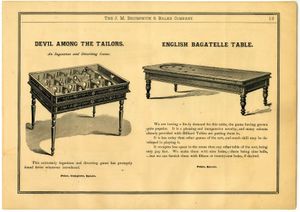Annotation:Devil Among the Tailors (1) (The): Difference between revisions
No edit summary |
No edit summary |
||
| Line 88: | Line 88: | ||
Petrie ('''Third Collection of Strathspey Reels'''), 1802; p. 18. | Petrie ('''Third Collection of Strathspey Reels'''), 1802; p. 18. | ||
Raven ('''English Country Dance Tunes'''), 1984; p. 170. | Raven ('''English Country Dance Tunes'''), 1984; p. 170. | ||
Edward Riley ('''Riley’s Flute Melodies vol. 1'''), New York, 1814, No. 198, p. 52. | |||
William Ross ('''Collection [of] Pipe Music'''), 1869; No. 177, p. 120. | William Ross ('''Collection [of] Pipe Music'''), 1869; No. 177, p. 120. | ||
'''Ryan's Mammoth Collection''', 1883; p. 42. | '''Ryan's Mammoth Collection''', 1883; p. 42. | ||
Revision as of 14:13, 22 February 2024
X:1 T:Deils among the Taylors [1], The M:C L:1/8 R:Reel B:Robert Petrie – Third Collection of Strathspey Reels (p. 18) N:Dedicated to Francis Garden Esq. Junior of Troup by N:Robert Petrie at Kirkmichael. Z:AK/Fiddler’s Companion K:A a2 eg a2 eg|a2 ea {f}d2 dc|dfBf dfBf|dfBf {a}g2fe| a2 eg a2eg|a2 ea {f}e2 dc|defd ecBA|E2G2A4|| ceAe ceAe|ceAe {f}d2 dc|dfBf dfBf|dfBf {g}f2 ed| ceAe ceAe|ceAe {f}e2 dc|defd ecBA|E2G2A4|]

English novelist Thomas Hardy mentions the tune in Absent Mindedness in a Parish Choir, a passage that bears repeating:
...Twas a very dark afternoon, and by the end of the sermon all you could see of the inside of the church were the pa'son's two candles alongside of him in the pulpit, and his spaking face behind 'em. The sermon being ended at last, the pa'son gi'ed out the Evening Hymn. But no quire set about sounding up the tune, and the people began to turn their heads to learn the reason why, and then Levi Limpet, a boy who sat in the gallery, nudged Timothy and Nicholas, and said, "Begin! Begin!" "Hey? what?" says Nicholas, starting up; and the church being so dark and his head so muddled he thought he was at the party they had played at all the night before, and away he went, bow and fiddle, at "The Devil among the Tailors," the favourite jig of the neighborhood at that time. The rest of the band, being in the same state of mind and nothing doubting, followed their leader with all their strength, according to custom. They poured out that there tune till the lower bass notes of "The Devil among the Tailors" made the cobwebs in the roof shiver like ghosts; then Nicholas, seeing nobody moved, shouted out as he scraped (in his usual commanding way at dances when the folks didn't know the figures), "Top couples cross hands! And when I make the fiddle squeak at the end every man kiss his partner under the mistletoe!"
...Then the unfortunate church band came to their senses, and remembered where they were; and 'twas a sight to see Nicholas Puddingcome and Timothy Thomas and John Biles creep down the gallery stairs with their fiddles under arms, and poor Dan'l Hornhead with his serpent, and Robert Dowdle with his claionet, all looking as little as ninepins; and out they went. The pa'son might have forgi'ed 'em when he learned the truth o't, but the squire would not. That very week he sent for a barrel-organ that would play two-and-twenty new psalm-tunes, so exact and particular that, however sinful inclined you was, you could play nothing but psalm-tunes whatsomever. He had a really respectable man to turn the winch, as I said, and the old players played no more...
One of the oddest recreations (recordings?) of the tune is on the barrel organ from the polar expedition of Admiral Parry of 1819. In place of a ship's fiddler (common in those days), Parry introduced a mechanical barrel organ on board ship to provide entertainment and a vehicle to which the men could exercise (i.e. by dancing). "Devil Among the Tailors" was one of eight tunes on barrel no. 5. Perhaps the earliest non-mechanical sound recording is from 1906 by violinist Charles D'Alamaine, born in 1871 in England, who died in 1943. D'Alamaine immigrated to the United States in 1888, and by 1890 had established himself as "instructor on violin" in Evanston, Illinois; by 1910 he had removed to Yonkers, and in 1920 was a chiropractor in New York City (info. from Paul Gifford).
